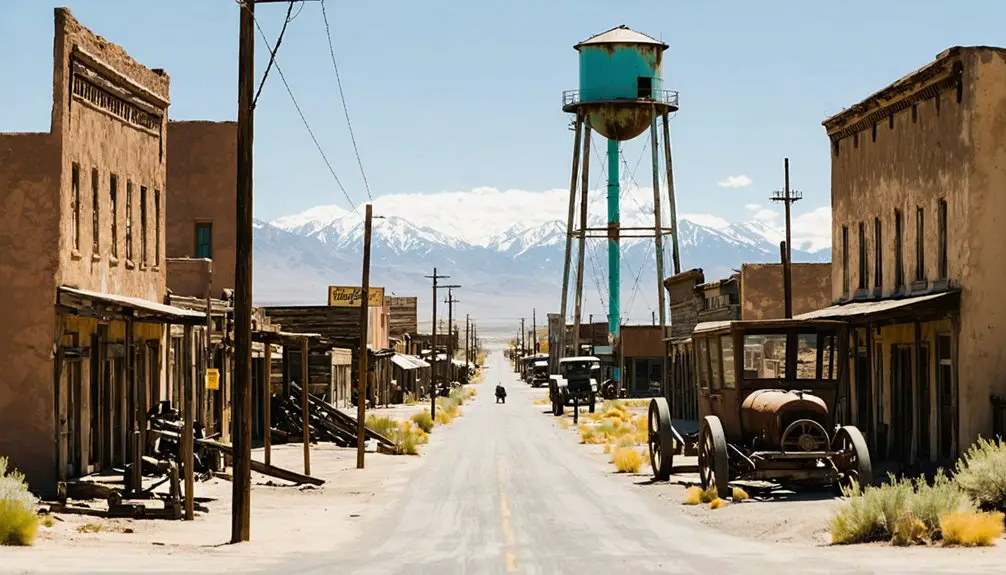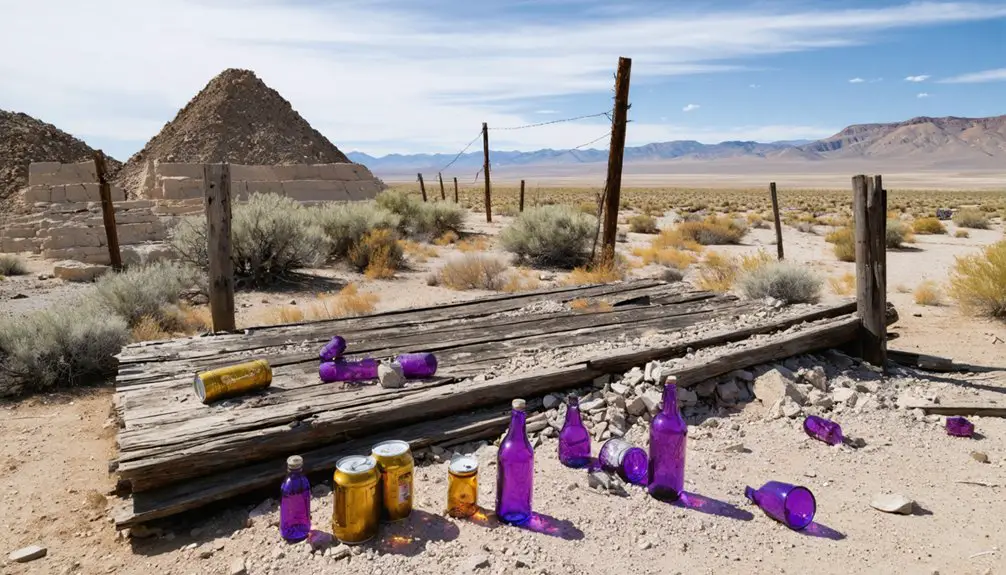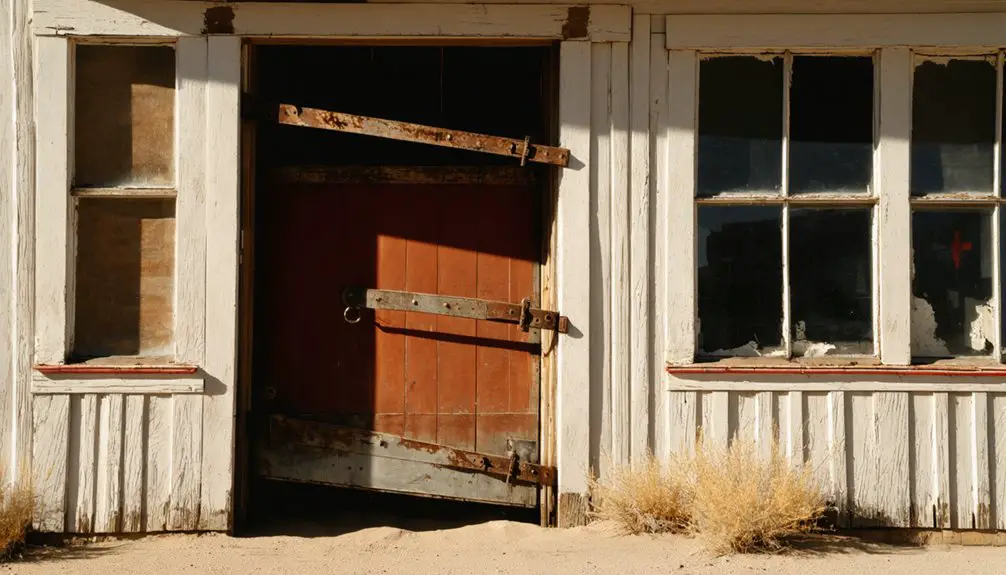You’ll find Star City’s ghost town remains in Nevada’s Humboldt County, where silver deposits transformed this remote canyon into a bustling 1,200-person settlement by 1861. The Queen of Sheba mine generated $5 million in revenue between 1862-1868, supporting numerous businesses and services. After ore depletion in 1868, the population plummeted by 1,600% within three years. Today, only stone foundations and mine tailings mark this dramatic example of Nevada’s silver rush era, though its complete story reveals much more.
Key Takeaways
- Star City was established in 1861 after silver deposits were discovered in Star Canyon, becoming Nevada’s largest settlement in Humboldt County.
- The town peaked between 1864-1865 with 1,200 residents, supported by seven mining companies and the productive Queen of Sheba mine.
- Essential services included hotels, stores, saloons, and a Wells Fargo office, making it a thriving commercial center during the silver boom.
- The town experienced rapid decline after 1868 when ore reserves depleted, dropping to just 78 residents by 1871.
- Today, only stone foundations, an abandoned mine shaft, and scattered mine tailings remain as evidence of Star City’s mining past.
The Birth of a Silver Boomtown
When prospectors discovered rich silver deposits in Star Canyon in 1861, they set in motion the rapid establishment of Star City in Nevada’s Star Mining District.
The discovery of Star Canyon’s silver in 1861 sparked the creation of Star City, a testament to Nevada’s mining ambitions.
You’ll find that within just two years, this frontier outpost transformed into Humboldt County‘s largest settlement, boasting 1,200 residents drawn by the promise of mineral wealth and mining technology that could extract it.
As local folklore tells it, the rush to establish essential services matched the fervor of the silver strikes themselves. A diverse business district emerged with two bustling hotels, stores, and numerous saloons to serve the growing population.
By 1862, you’d have seen a post office, followed quickly by the emergence of commercial infrastructure including Wells Fargo operations.
The area’s development accelerated as seven mining companies staked their claims, with the Queen of Sheba mine leading the charge. The Queen of Sheba mine proved to be incredibly lucrative, generating an impressive $5 million in revenue between 1862 and 1868.
This concentrated burst of activity established Star City as a significant hub in Nevada’s early mining frontier.
Life in Early Star City
In Star City’s heyday, you’d have found miners living in wooden structures while accessing essential services from the town’s two hotels, three general stores, and Wells Fargo office.
You could have joined your fellow citizens at one of a dozen saloons or the local church, which formed the social backbone of this 1,200-person community at its peak.
Your daily routines would have centered around the bustling mining operations of seven companies, particularly the Queen of Sheba mine, which anchored the town’s economy and employed most of its residents.
Much like in Star Canyon, another nearby mining area, prospectors searched tirelessly for valuable mineral deposits.
The Queen of Sheba mine produced $5 million in silver during its most productive period in the mid-1860s.
Mining Camp Living Conditions
The harsh realities of life in Star City’s mining camp exemplified the challenging conditions faced throughout Nevada’s 1860s silver boom settlements.
You’d have found yourself living in canvas tents at elevations above 10,000 feet, where the bitter mountain air constantly tested your resilience. As mining health deteriorated from dust exposure and dangerous underground work, the shelter evolution progressed slowly from temporary encampments to wooden structures in the 1880s.
You would’ve navigated crowded, unsanitary conditions while relying on boarding houses and local stores for basic necessities. The Patterson Mining District experienced its most intense activity between 1882 and 1883, bringing waves of fortune seekers to the harsh environment.
The ten-stamp mill’s constant operation reminded you of the town’s singular purpose, while the population’s dramatic fluctuation – from 1,200 to just 78 by 1871 – reflected the precarious nature of your frontier existence.
Social and Business Activities
Despite the harsh living conditions, Star City rapidly developed a vibrant commercial district that served its growing population’s social and economic needs.
You’d find two hotels, three general stores, and numerous saloons dotting the streets, while a Wells Fargo office and telegraph station facilitated financial transactions and communication.
Business competition thrived as seven mining companies operated simultaneously, with the Queen of Sheba Mine leading production at $5 million in silver output.
Social gatherings centered around the saloons and hotels, where miners exchanged news and conducted informal business. The town’s central plaza area became a primary location for commerce and community events.
The post office, opened in 1862, became a community hub until the town’s decline in 1868.
As mining operations dwindled, Star City’s population plummeted from 1,200 to under 80 by 1871, and its once-bustling commercial district faded into history.
Civic Development and Services
While Star City’s rapid growth demanded robust civic infrastructure, the town established crucial services remarkably quickly between 1862-1865. Community governance centered around mining interests, with civic engagement manifesting through informal town meetings and business partnerships.
You’d find a well-organized network of critical services that supported daily life and commerce.
- Communication services through the post office and telegraph office enabled you to stay connected, while Wells Fargo’s presence secured your financial transactions.
- Key institutions like the church and school fostered social stability and education for your children.
- Basic utilities including water from the Humboldt Range and 24-hour mill operations sustained both domestic and industrial needs.
Mining Operations and Economic Growth
Following silver’s discovery in Star Canyon during 1861, Star City rapidly evolved into Humboldt County‘s largest settlement, driven by intensive mining operations that would ultimately yield approximately $5 million in precious metals.
Mining techniques advanced from basic prospecting to sophisticated ore processing, with seven companies operating during the peak years of 1864-1865.
As mining evolved beyond simple prospecting, Star City’s seven companies pioneered advanced ore processing methods during the district’s golden age.
The Queen of Sheba mine emerged as the district’s powerhouse, utilizing a ten-stamp mill that operated around the clock. This industrial activity created economic stability that supported 1,200 residents and numerous businesses, including a Wells Fargo branch and telegraph office.
However, by 1868, depleting ore reserves triggered a swift decline. The population plummeted to just 78 residents by 1871, and by 1880, Star City’s mining boom had come to an end.
Community Development and Infrastructure

As Star City materialized in 1861, its initial infrastructure consisted primarily of canvas tents and temporary shelters characteristic of hastily established mining settlements.
The town’s emergence reflected how mining boom cycles rapidly transformed the Nevada landscape.
Similar to modern rural Nevada communities, Star City faced significant challenges in attracting and retaining workers due to its remote location.
Despite infrastructure challenges at 10,200 feet elevation, you’ll find the community demonstrated remarkable resilience by establishing essential services.
- The town developed critical amenities including two hotels, multiple general stores, and a Wells Fargo office to handle banking and ore transactions.
- Community institutions expanded to include a church and approximately twelve saloons, reflecting both spiritual and social priorities.
- By the 1880s, wooden structures replaced temporary shelters, though limited transportation access and harsh mountain conditions hindered further development.
The absence of railroad connections and remote location ultimately contributed to Star City’s decline, with postal services relocating to Sweetwater by 1894 as population dwindled from 1,200 to near-zero.
The Queen of Sheba Mine’s Glory Days
During its peak operations in 1864-1865, you’d find seven mining companies working throughout Star Canyon, with the Queen of Sheba Mine emerging as the district’s powerhouse producer.
The silver-lead ore deposits filled prominent fault fissures in the local rhyolite, making the mine’s distinct low-sulfide Au-quartz vein deposits particularly valuable for precious metal extraction.
You’ll note that the mine’s ten-stamp mill operated around the clock, contributing to an impressive total yield of $5 million in silver between 1862 and 1868.
Your analysis of the economic impact would reveal that this production directly fueled Star City’s rapid growth to 1,200 residents by 1863, making it Humboldt County’s most populous settlement.
Mining Operations Peak
The Queen of Sheba Mine transformed Star City into a thriving mining hub between 1864 and 1865, while seven distinct mining companies operated simultaneously in Star Canyon.
During peak mining operations, the Sheba Mining Company’s ten-stamp mill crushed silver ore around the clock, yielding an impressive $5 million in total recovery throughout the 1860s.
- The mines exploited high-grade stockwork vein deposits containing silver, lead, antimony, copper, gold, and zinc at elevations reaching 6,800 feet.
- Mining infrastructure expanded rapidly to include hotels, saloons, stores, a school, telegraph office, and Wells Fargo branch.
- Ore depletion began around 1868, leading to a swift decline that reduced the population to just 78 residents by 1871, before the town’s complete abandonment by 1880.
Silver Production Records
Mining records from the Queen of Sheba operation showcase remarkable silver production figures that defined Star City’s meteoric rise in Nevada’s mining history.
You’ll find that during its operational years from 1862 to 1868, the mine yielded an impressive $5 million in silver, leveraging silver extraction methods that included a continuously running ten-stamp mill.
The mining technology advancements of the era, particularly in ore crushing and processing, enabled the company to efficiently extract silver alongside valuable deposits of lead and antimony.
The mine’s prolific output transformed Star City into Humboldt County’s largest settlement, supporting a thriving community of 1,200 residents.
Through strategic exploitation of stockwork vein deposits and stoping techniques, the Queen of Sheba’s production levels sustained the region’s economic significance until its decline in 1868.
Economic Impact Analysis
As Star City’s premier economic engine, Queen of Sheba Mine catalyzed unprecedented regional growth between 1862-1868, generating $5 million in silver revenue while supporting a complex network of auxiliary businesses.
The mine’s economic diversification strategies fostered community resilience factors through continuous operations, employing a ten-stamp mill that ran 24 hours daily.
You’ll find these key economic indicators of Star City’s prosperity:
- Seven mining companies established operations by 1864-65, stimulating hotels, saloons, and banking services
- Wells Fargo’s presence integrated local silver production into broader financial markets
- Telegraph infrastructure enabled swift business communications and investment coordination
Star City’s economic foundation relied heavily on Queen of Sheba’s success, as evidenced by the town’s rapid decline following ore depletion, dropping from 1,200 residents to fewer than 80 within a decade.
The Rapid Decline and Exodus
While Star City achieved its peak population of 1,200 residents in 1863 as Humboldt County’s largest settlement, its decline proved remarkably swift and irreversible.
You’ll find that within just three years, population shifts reduced the town to merely 78 inhabitants, reflecting a staggering 1600% decrease.
The mining decline accelerated this exodus, as the Queen of Sheba mine’s productivity plummeted after 1868.
You’d have witnessed the closure of essential services – schools, Wells Fargo offices, and telegraph stations – as workers fled the failing economy.
Star City’s remote location in Star Canyon, coupled with inadequate transportation infrastructure, left remaining residents with little choice but to relocate.
What Remains Today

Today’s visitors to Star City’s remote location will find remarkably sparse evidence of its once-bustling population. The archaeological significance of the site lies primarily in its scattered remnants, with only a few crumbling stone foundations emerging from the sagebrush-covered hillside at 10,200 feet elevation.
Your ruins exploration will reveal:
- Three to four rock foundations and deteriorating walls near the Queen of Sheba head-frame
- A shallow, abandoned mine shaft with surrounding mill remnants
- Mine tailings scattered across the mountainside above a large flat area
Star Creek’s verdant vegetation contrasts sharply with the arid landscape, while the site’s isolation and minimal infrastructure attract primarily serious historians and adventurers seeking off-grid experiences.
The structures’ dismantlement after 1890 has left the location in a state of arrested decay.
Legacy of Nevada’s Silver Rush Era
The discovery of Nevada’s Comstock Lode in 1858-1859 established an unprecedented chapter in American mining history that fundamentally transformed the western United States.
You’ll find the silver mining legacy echoes through Nevada’s identity as the “Silver State,” with ghost towns scattered across the landscape telling stories of boom-and-bust cycles that shaped the American frontier.
These silver discoveries sparked reverse migration from California, establishing towns like Virginia City, Austin, Eureka, and Pioche.
While many of these settlements eventually declined, they left behind lasting infrastructure and technological innovations in ore processing.
Today, you can trace this heritage through the Walker Lane Trend, where modern mining operations continue to explore historic districts using advanced methods, driven by silver’s renewed importance in electric vehicle and solar panel manufacturing.
Frequently Asked Questions
Were There Any Notable Crimes or Lawlessness During Star City’s Peak Years?
You’ll find no documented evidence of significant crime rates, though typical mining-town disorder likely occurred. Without formal law enforcement records, any claims about notable lawlessness remain speculative.
What Happened to the Mining Equipment and Valuable Machinery After Abandonment?
While valuable equipment moved to nearby Unionville’s mines, you’ll find most abandoned machinery weathered away in Star City’s ruins. Some mining relics still scatter the landscape after 150+ years.
Did Any Famous Historical Figures Ever Visit Star City?
You won’t find any confirmed famous visitors in Star City’s historical records, though its brief period of historical significance from 1861-1868 likely attracted regional business figures and mining entrepreneurs.
What Was the Average Silver Miner’s Daily Wage in Star City?
Imagine risking your life daily underground – that’s what $3-$5 bought you. Your daily earnings as a silver miner reflected the harsh miner lifestyle, though some skilled workers could earn more.
Were There Any Major Accidents or Disasters in Star City’s Mines?
You won’t find documented major disasters in these mines based on available mine safety records. While nearby mines like Yellow Jacket experienced catastrophes, disaster reports don’t indicate significant accidents at this location.
References
- http://backyardtraveler.blogspot.com/2007/07/ghosts-of-star-city.html
- https://www.nvexpeditions.com/pershing/starcity.php
- https://www.youtube.com/watch?v=hcDA9YFAcZ0
- https://shpo.nv.gov/nevadas-historical-markers/historical-markers/star-city
- https://nvtami.com/2021/07/27/belfort-boulder-flat-star-city-california-sweetwater-sister-towns/
- http://starpointtradingpost.com/points-of-interest.html
- https://scripophily.net/buena-vista-gold-silver-mining-co-fort-pitt-ledge-prince-roya-district-humboldt-county-nevada-territory-1863/
- http://www.foresthillhistory.org/index_htm_files/Humboldt County Ghost Towns.pdf
- https://nvtami.com/2022/11/13/humboldt-pershing-county-ghost-towns/
- https://www.nevadacitychamber.com/images/gold_mining.pdf



